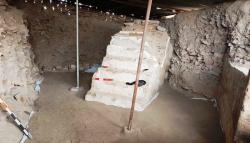INSTITUT SUPERIEUR D'ANTHROPOLOGIE
INSTITUTE OF ANTHROPOLOGY
ONLINE COURSES / COURS A DISTANCE
SPRING TERM : APRIL 2018
REGISTER NOW
CHINE – 
 Guangxi Zhuang - A team of archaeologists in China have unearthed a 16,000-year-old human skull after three years of investigation. The skull was found alongside tens of thousands of stone artifacts in south China's Guangxi Zhuang Autonomous Region. Researcher Yu Minghui told the Chinese news agency Xinhuanet it was the only complete skull from that period ever found in southern China. The skull was discovered inside a cave system that covers over 100 square meters that was discovered back in 2014. The site was the second area of Palaeolithic tombs to be found in China. The Yahuai cave site in Longan County, yielded other interesting findings as well - including animal teeth of unknown origin. The research team have been examining the area since June 2015.
Guangxi Zhuang - A team of archaeologists in China have unearthed a 16,000-year-old human skull after three years of investigation. The skull was found alongside tens of thousands of stone artifacts in south China's Guangxi Zhuang Autonomous Region. Researcher Yu Minghui told the Chinese news agency Xinhuanet it was the only complete skull from that period ever found in southern China. The skull was discovered inside a cave system that covers over 100 square meters that was discovered back in 2014. The site was the second area of Palaeolithic tombs to be found in China. The Yahuai cave site in Longan County, yielded other interesting findings as well - including animal teeth of unknown origin. The research team have been examining the area since June 2015.
https://www.mirror.co.uk/science/tomb-raiders-china-discover-16000-12372603
INDE –  Tso Moriri Lake - Scientists from the Indian Institute of Technology, Kharagpur, have gathered evidence that shows the drought extended for 900 years, which eventually drove these otherwise-hardy people towards the east and south, where rain conditions were better. The startling revelation will be published in the prestigious Quaternary International Journal of Elsevier this month. Researchers from the geology and geophysics department have been studying the monsoon’s variability for the past 5,000 years and can now say with certainty that for 900 long years, the rains played truant in the North-West Himalayas, drying up the source of water that fed the rivers along which the civilisation thrived. It is accepted by archaeologists and historians that the Indus Valley civilisation was not only limited to the banks of the Indus but had footprints along the Ravi, Chenub, Beas and Sutlej too. The IIT-Kgp team has mapped a 5,000-year monsoon variability in the Tso Moriri Lake in Leh-Ladakh, which too was fed by the same glacial source and identified periods that had continuous spells of good monsoon as also the phases of weak and near-no-monsoon.
Tso Moriri Lake - Scientists from the Indian Institute of Technology, Kharagpur, have gathered evidence that shows the drought extended for 900 years, which eventually drove these otherwise-hardy people towards the east and south, where rain conditions were better. The startling revelation will be published in the prestigious Quaternary International Journal of Elsevier this month. Researchers from the geology and geophysics department have been studying the monsoon’s variability for the past 5,000 years and can now say with certainty that for 900 long years, the rains played truant in the North-West Himalayas, drying up the source of water that fed the rivers along which the civilisation thrived. It is accepted by archaeologists and historians that the Indus Valley civilisation was not only limited to the banks of the Indus but had footprints along the Ravi, Chenub, Beas and Sutlej too. The IIT-Kgp team has mapped a 5,000-year monsoon variability in the Tso Moriri Lake in Leh-Ladakh, which too was fed by the same glacial source and identified periods that had continuous spells of good monsoon as also the phases of weak and near-no-monsoon.
https://timesofindia.indiatimes.com/city/kolkata/a-900-yr-drought-ended-indus-civilisation-says-iit-kgp-study/articleshow/63776598.cms
IRAN –  Sang-Bast - Vestiges of a centuries-old mosque have recently been brought to light during an archaeological excavation in Sang-Bast Rural District of Fariman County, northeast Iran. Discoveries include stucco-ornamented columns, brick-flooring spaces and a minbar or pulpit, where prayer leader sits to deliver sermons, IRNA reported on Sunday. The ancient mosque is adjacent to the ruins of a caravanserai, a public bathhouse, a bazaar and other historical sites in Razavi Khorasan Province. Most of the architectural elements of the site date from the Ghaznavid era (977–1186). Sang-Bast is where Iran’s earliest brick minaret stands, the report said.
Sang-Bast - Vestiges of a centuries-old mosque have recently been brought to light during an archaeological excavation in Sang-Bast Rural District of Fariman County, northeast Iran. Discoveries include stucco-ornamented columns, brick-flooring spaces and a minbar or pulpit, where prayer leader sits to deliver sermons, IRNA reported on Sunday. The ancient mosque is adjacent to the ruins of a caravanserai, a public bathhouse, a bazaar and other historical sites in Razavi Khorasan Province. Most of the architectural elements of the site date from the Ghaznavid era (977–1186). Sang-Bast is where Iran’s earliest brick minaret stands, the report said.
http://www.tehrantimes.com/news/422683/Remains-of-centuries-old-mosque-unearthed-in-Fariman